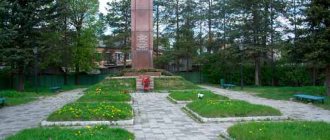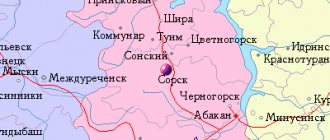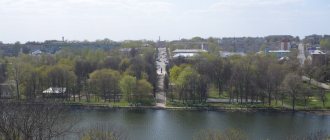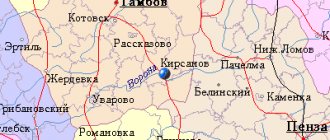History[ | ]
The settlement arose in the second half of the 19th century as a settlement at the railway station of the Nikolaevskaya Railway on the way from St. Petersburg to Moscow. Before the opening of the station, there were several churchyards in the surrounding area. To the east, in the Spassky Moss swamp, there was the Spassky Pogost, on the site of which the Spaso-Oskuyskaya Hermitage was created in the 16th century, abolished in 1764. Nearby on the Mda River were the Kremenetsky churchyard and Nebolotsky churchyard.
The first building of Malaya Vishera is considered to be a state-owned hut for the clerk, foreman and other managers of the construction of this section of the Nikolaev railway, built in 1843 by an artel of serfs on the banks of the Malaya Vishera river. In 1851, a high-class railway station building was built according to the design of the architect R. A. Zhelyazevich.
On December 18, 1871, the settlement at Malaya Vishera station was transferred to the category of posad.
Malaya Vishera in the 1860s
In 1868-1874, during hunting trips along the Nikolaev Railway line, Emperor Alexander II visited Malaya Vishera twice a season.
On December 29, 1870, during the hunt of Alexander II near Malaya Vishera, Chief Jägermeister Count Fersen accidentally killed Jägermeister V. Ya. Skaryatin.
On February 5, 1874, Emperor of Austria-Hungary Franz Joseph visited Malaya Vishera. On February 6, 1874, Franz Joseph and Alexander II hunted a bear near Malaya Vishera.
In 1879, the first telephone conversation in Russia took place over wires on the St. Petersburg - Malaya Vishera line.
In 1917, on the night of February 28 (March 13) to March 1 (March 14), a royal train with Emperor Nicholas II, heading to Tsarskoe Selo, arrived at the Malaya Vishera station. Here the train was delayed, since further stations Lyuban and Tosno were occupied by troops who rebelled as a result of the February Revolution. It was decided to go from Malaya Vishera by a roundabout route to Tsarskoe Selo, but on the way the route was changed and the train went to Pskov, where on March 2 (March 15) Emperor Nicholas II abdicated the throne in favor of his brother, Grand Duke Mikhail Alexandrovich[3] .
On March 10, 1918, at the Malaya Vishera station, a train carrying Vladimir Ilyich Lenin encountered hostile anarchist sailors who had voluntarily fled from the front. The “anarchist train” was disarmed with the help of Latvian riflemen.
In 1918-1927, Malaya Vishera was the administrative center of the Malovishera district of the Novgorod province.
In 1921, Malaya Vishera received city status[2].
During the Great Patriotic War, Malaya Vishera was occupied by troops of the 16th Wehrmacht Army on October 24, 1941 during the Tikhvin defensive operation. However, less than a month later, as a result of a counteroffensive on November 20, 1941, the city was liberated by troops of the 111th and 259th rifle divisions of the 52nd separate army. In February 1942, K. E. Voroshilov, as a representative of the Headquarters of the Supreme High Command, visited the headquarters of the Volkhov Front in the city of Malaya Vishera.
Excerpt characterizing Malaya Vishera
Having finished his second glass of punch, Napoleon went to rest before the serious business that, as it seemed to him, lay ahead of him the next day. He was so interested in this task ahead of him that he could not sleep and, despite the runny nose that had worsened from the evening dampness, at three o'clock in the morning, blowing his nose loudly, he went out into the large compartment of the tent. He asked if the Russians had left? He was told that the enemy fires were still in the same places. He nodded his head approvingly. The adjutant on duty entered the tent. - Eh bien, Rapp, croyez vous, que nous ferons do bonnes affaires aujourd'hui? [Well, Rapp, what do you think: will our affairs be good today?] - he turned to him. “Sans aucun doute, sire, [Without any doubt, sir,” answered Rapp. Napoleon looked at him. “Vous rappelez vous, Sire, ce que vous m'avez fait l'honneur de dire a Smolensk,” said Rapp, “le vin est tire, il faut le boire.” [Do you remember, sir, those words that you deigned to say to me in Smolensk, the wine is uncorked, I must drink it.] Napoleon frowned and sat silently for a long time, his head on his hand. “Cette pauvre armee,” he said suddenly, “elle a bien diminue depuis Smolensk.” La fortune est une franche courtisane, Rapp; je le disais toujours, et je commence a l'eprouver. Mais la garde, Rapp, la garde est intact? [Poor army! it has greatly diminished from Smolensk. Fortune is a real minx, Rapp. I've always said this and I'm starting to experience it. But the guard, Rapp, the guard is intact?] - he said questioningly. “Oui, Sire, [Yes, sir.],” answered Rapp. Napoleon took the lozenge, put it in his mouth and looked at his watch. He didn’t want to sleep; morning was still far away; and in order to kill time, no orders could be made anymore, because everything had been done and was now being carried out. – A t on distribue les biscuits et le riz aux regiments de la garde? [Did they distribute crackers and rice to the guards?] - Napoleon asked sternly. – Oui, Sire. [Yes, sir.] – Mais le riz? [But rice?] Rapp replied that he had conveyed the sovereign’s orders about rice, but Napoleon shook his head with displeasure, as if he did not believe that his order would be carried out. The servant came in with punch. Napoleon ordered another glass to be brought to Rapp and silently took sips from his own. “I have neither taste nor smell,” he said, sniffing the glass. “I’m tired of this runny nose.” They talk about medicine. What kind of medicine is there when they cannot cure a runny nose? Corvisar gave me these lozenges, but they don't help. What can they treat? It cannot be treated. Notre corps est une machine a vivre. Il est organise pour cela, c'est sa nature; laissez y la vie a son aise, qu'elle s'y defende elle meme: elle fera plus que si vous la paralysiez en l'encombrant de remedes. Notre corps est comme une montre parfaite qui doit aller un certain temps; l'horloger n'a pas la faculte de l'ouvrir, il ne peut la manier qu'a tatons et les yeux bandes. Notre corps est une machine a vivre, voila tout. [Our body is a machine for life. This is what it is designed for. Leave the life in him alone, let her defend herself, she will do more on her own than when you interfere with her with medications. Our body is like a clock that must run for a certain time; The watchmaker cannot open them and can only operate them by touch and blindfolded. Our body is a machine for life. That's all.] - And as if having embarked on the path of definitions, definitions that Napoleon loved, he suddenly made a new definition. – Do you know, Rapp, what the art of war is? - he asked. – The art of being stronger than the enemy at a certain moment. Voila tout. [That's all.] Rapp didn't answer. – Demainnous allons avoir affaire a Koutouzoff! [Tomorrow we will deal with Kutuzov!] - said Napoleon. - Let's see! Remember, at Braunau he commanded the army and not once in three weeks did he mount a horse to inspect the fortifications. Let's see! He looked at his watch. It was still only four o'clock. I didn’t want to sleep, I had finished the punch, and there was still nothing to do. He got up, walked back and forth, put on a warm frock coat and hat and left the tent. The night was dark and damp; a barely audible dampness fell from above. The fires did not burn brightly nearby, in the French guard, and glittered far through the smoke along the Russian line. Everywhere it was quiet, and the rustling and trampling of the French troops, which had already begun to move to occupy a position, could clearly be heard. Napoleon walked in front of the tent, looked at the lights, listened to the stomping and, passing by a tall guardsman in a shaggy hat, who stood sentry at his tent and, like a black pillar, stretched out when the emperor appeared, stopped opposite him. - Since what year have you been in the service? - he asked with that usual affectation of rough and gentle belligerence with which he always treated the soldiers. The soldier answered him. - Ah! un des vieux! [A! of the old people!] Did you receive rice for the regiment? - We got it, Your Majesty. Napoleon nodded his head and walked away from him. At half past five Napoleon rode on horseback to the village of Shevardin. It was beginning to get light, the sky cleared, only one cloud lay in the east. Abandoned fires burned out in the weak morning light. A thick, lonely cannon shot rang out to the right, rushed past and froze in the midst of general silence. Several minutes passed. A second, third shot rang out, the air began to vibrate; the fourth and fifth sounded close and solemnly somewhere to the right. The first shots had not yet sounded when others were heard, again and again, merging and interrupting one another. Napoleon rode up with his retinue to the Shevardinsky redoubt and dismounted from his horse. The game has begun. Returning from Prince Andrei to Gorki, Pierre, having ordered the horseman to prepare the horses and wake him up early in the morning, immediately fell asleep behind the partition, in the corner that Boris had given him. When Pierre fully woke up the next morning, there was no one in the hut. Glass rattled in the small windows. The bereitor stood pushing him away. “Your Excellency, your Excellency, your Excellency...” the bereitor said stubbornly, without looking at Pierre and, apparently, having lost hope of waking him up, swinging him by the shoulder. - What? Began? Is it time? - Pierre spoke, waking up. “If you please hear the firing,” said the bereitor, a retired soldier, “all the gentlemen have already left, the most illustrious ones themselves have passed a long time ago.” Pierre quickly got dressed and ran out onto the porch. It was clear, fresh, dewy and cheerful outside. The sun, having just broken out from behind the cloud that was obscuring it, splashed half-broken rays through the roofs of the opposite street, onto the dew-covered dust of the road, onto the walls of the houses, onto the windows of the fence and onto Pierre’s horses standing at the hut. The roar of the guns could be heard more clearly in the yard. An adjutant with a Cossack trotted down the street. - It's time, Count, it's time! - shouted the adjutant. Having ordered his horse to be led, Pierre walked down the street to the mound from which he had looked at the battlefield yesterday. On this mound there was a crowd of military men, and the French conversation of the staff could be heard, and the gray head of Kutuzov could be seen with his white cap with a red band and the gray back of his head, sunk into his shoulders. Kutuzov looked through the pipe ahead along the main road. Entering the entrance steps to the mound, Pierre looked ahead of him and froze in admiration at the beauty of the spectacle. It was the same panorama that he had admired yesterday from this mound; but now this entire area was covered with troops and the smoke of gunfire, and the slanting rays of the bright sun, rising from behind, to the left of Pierre, threw upon it in the clear morning air a piercing light with a golden and pink tint and dark, long shadows. The distant forests that completed the panorama, as if carved from some precious yellow-green stone, were visible with their curved line of peaks on the horizon, and between them, behind Valuev, cut through the great Smolensk road, all covered with troops. Golden fields and copses glittered closer. Troops were visible everywhere - in front, right and left. It was all lively, majestic and unexpected; but what struck Pierre most of all was the view of the battlefield itself, Borodino and the ravine above Kolocheya on both sides of it.
Population[ | ]
| Population | |||||||||
| 1885[4] | 1897[5] | 1917[6] | 1920[6] | 1923[6] | 1926[7] | 1931[8] | 1937[9] | 1939[10] | 1943[11] |
| 4076 | ↗4851 | ↗7287 | ↘7153 | ↘6932 | ↗9432 | ↗11 600 | ↗15 058 | ↗17 620 | ↘6852 |
| 1959[12] | 1967[8] | 1970[13] | 1979[14] | 1989[15] | 1992[8] | 1996[8] | 1998[8] | 2001[8] | 2002[16] |
| ↗16 109 | ↘15 000 | ↗15 381 | ↗15 724 | ↘15 647 | ↘15 400 | ↘15 000 | ↘14 800 | ↘14 500 | ↘14 182 |
| 2003[8] | 2005[8] | 2006[8] | 2007[8] | 2008 | 2009[17] | 2010[18] | 2011[8] | 2012[19] | 2013[20] |
| ↗14 200 | ↘13 700 | ↘13 300 | ↘13 100 | ↘12 920 | ↘12 627 | ↘12 461 | ↗12 500 | ↘12 140 | ↘11 998 |
| 2014[21] | 2015[22] | 2016[23] | 2017[24] | 2018[25] | 2019[26] | 2020[27] | 2021[1] | ||
| ↘11 789 | ↘11 601 | ↘11 297 | ↘11 015 | ↘10 602 | ↘10 371 | ↘10 253 | ↘10 161 | ||
As of January 1, 2021, in terms of population, the city was in 908th place out of 1,116[28]cities of the Russian Federation[29].
Economics [edit]
Industry[edit]
In the past, the economy of Malaya Vishera depended on the glass factory, which began to experience serious difficulties in the 1990–2000s. Currently, these are the wood processing industry (including furniture production), the food industry and the production of tools. [16]
Transport[edit]
Malaya Vishera railway station
In 1860, a railway depot was opened in Malaya Vishera. Long-distance trains stop at this station (including Moscow - St. Petersburg). The station is also an important terminus for regional commuter trains from Okulovka, Volkhovstroy and St. Petersburg.
Malaya Vishera is connected by highways to the M10 highway and to Lyubytino. The M10 passes 40 km west of the city.
Cultural institutions[ | ]
- [30] Municipal cultural institution “Inter-settlement library system of Malovishera district”
- Museum of School No. 1
- Malovishera Regional Museum of Local Lore
The museum has an exhibition hall, expositions on the history of the formation of Malaya Vishera, and memorable places of the Malovishera district. Municipal budgetary cultural institution. Intersettlement Methodological Center for Folk Art and Cultural and Leisure Activities (MBUK MMTSNT and KDD) and its branch RDK “Svetlana”.
Transport[ | ]
City bus Entrance to the city of Malaya Vishera
There is one city bus route in the city:
- 1 Komsomolsky village - Central district hospital - Department store - State farm "Malovishersky"
The route is served by Malovishersky PATP.
Intercity bus service
- Malaya Vishera - Novgorod
- Novgorod — Lyubytino
- Novgorod — Pestovo
- St. Petersburg - Malaya Vishera - Borovichi
Suburban electric trains
As of January 26, 2012
- Malaya Vishera - St. Petersburg (4 times a day)
- Malaya Vishera - Okulovka (Mon-Fri, Sun 3 times a day, Sat - 2 times a day)
- Malaya Vishera - Novgorod (once a day)
- Malaya Vishera - Volkhovstroy-1 (once a day)
Narrow-gauge railway
Until 2003, an active timber-carrying narrow-gauge railway departed from the city to the northeast. In the years following the collapse of the USSR, the rails of this road, which became ownerless, were gradually plundered. Currently the road does not exist.
History[edit]
Malaya Vishera in the 1860s
The city's name comes from the Malaya Vishera River, a tributary of the Vishera River. Laid down in 1843 as the construction of Moskovsky Avenue in St. Petersburg. The St. Petersburg Railway began through the modern city (opened in 1851). [ Edit
] At that time, it was part of Krestetsky Uyezd of the Novgorod Governorate.
On February 24, 1918, Malovishera district was formed, and Malaya Vishera became its residence. [11] In 1921, Malaya Vishera received city status. [ citation needed
]
In August 1927, the districts were abolished, and on October 1, 1927, the Malovishera district was formed with the administrative center in Malaya Vishera. [12] The Novgorod Governorate was abolished, and the district also became part of the Novgorod Okrug in the Leningrad Region. [12] On July 23, 1930, the districts were abolished, and the districts were directly subordinated to the region. [12]
During World War II, from October 23 to December 22, 1941, Malaya Vishera was occupied by German troops. [13] It became the eighth Soviet city to be liberated by Soviet troops in 1941, and the first not to be subsequently reoccupied. [14]
On July 5, 1944, Malovishersky District became part of the newly formed Novgorod Region and has remained there ever since. [15]
Notes[ | ]
- ↑ 123
The permanent population of the Russian Federation by municipalities as of January 1, 2021 (Russian). Date accessed: April 27, 2021. Archived May 2, 2021. - ↑ 12
THE USSR. Administrative-territorial division of the union republics on January 1, 1980 / Comp. V. A. Dudarev, N. A. Evseeva. - M.: Izvestia, 1980. - 702 p. — P. 180. - Abdication of Nicholas II. Memoirs of eyewitnesses
- Statistics of the Russian Empire. 1: Collection of information on Russia for 1884-1885. St. Petersburg, 1887, p. 20
- Populated areas of the Russian Empire with 500 or more inhabitants, indicating the total population present in them and the number of inhabitants of the prevailing religions, according to the first general census of 1897 / Rep. ed. N. A. Troinitsky. - St. Petersburg, 1905, p. 126
- ↑ 123
Cities of the USSR / NKVD of the RSFSR, Stat. Department. - M., 1927 - Bulletin of the Leningrad Regional Statistics Department. Vol. 20. 1928, April - June
- ↑ 1234567891011
People's encyclopedia "My City". Malaya Vishera - All-Union Population Census of 1937: General results. Collection of documents and materials - M., 2007, p. 68
- RGAE, f. 1562, op. 336, no. 1248, pp. 83-96
- TsGA SPb., f. 95, op. 6, no. 5, pp. 2—3
- All-Union Population Census of 1959. The size of the urban population of the RSFSR, its territorial units, urban settlements and urban areas by gender (Russian). Demoscope Weekly. Access date: September 25, 2013. Archived April 28, 2013.
- All-Union Population Census of 1970 The size of the urban population of the RSFSR, its territorial units, urban settlements and urban areas by gender. (Russian). Demoscope Weekly. Access date: September 25, 2013. Archived April 28, 2013.
- All-Union Population Census of 1979 The size of the urban population of the RSFSR, its territorial units, urban settlements and urban areas by gender. (Russian). Demoscope Weekly. Access date: September 25, 2013. Archived April 28, 2013.
- All-Union population census of 1989. Urban population (undefined)
. Archived from the original on August 22, 2011. - All-Russian population census 2002. Volume. 1, table 4. Population of Russia, federal districts, constituent entities of the Russian Federation, districts, urban settlements, rural settlements - regional centers and rural settlements with a population of 3 thousand or more (unspecified)
. Archived from the original on February 3, 2012. - The size of the permanent population of the Russian Federation by cities, urban-type settlements and regions as of January 1, 2009 (unspecified)
. Retrieved January 2, 2014. Archived January 2, 2014. - All-Russian population census 2010. 12. Population of municipal districts, settlements, urban and rural settlements of the Novgorod region (unspecified)
. Access date: February 2, 2014. Archived February 2, 2014. - Population of the Russian Federation by municipalities. Table 35. Estimated resident population as of January 1, 2012 (unspecified)
. Retrieved May 31, 2014. Archived May 31, 2014. - Population of the Russian Federation by municipalities as of January 1, 2013. - M.: Federal State Statistics Service Rosstat, 2013. - 528 p. (Table 33. Population of urban districts, municipal districts, urban and rural settlements, urban settlements, rural settlements) (undefined)
. Retrieved November 16, 2013. Archived November 16, 2013. - Table 33. Population of the Russian Federation by municipalities as of January 1, 2014 (unspecified)
. Access date: August 2, 2014. Archived August 2, 2014. - Population of the Russian Federation by municipalities as of January 1, 2015 (unspecified)
. Access date: August 6, 2015. Archived August 6, 2015. - Population of the Russian Federation by municipalities as of January 1, 2021 (Russian) (October 5, 2018). Date accessed: May 15, 2021. Archived May 8, 2021.
- Population of the Russian Federation by municipalities as of January 1, 2021 (Russian) (July 31, 2017). Retrieved July 31, 2021. Archived July 31, 2021.
- Population of the Russian Federation by municipalities as of January 1, 2021 (Russian). Retrieved July 25, 2018. Archived July 26, 2021.
- Population of the Russian Federation by municipalities as of January 1, 2021 (Russian). Date accessed: July 31, 2019. Archived May 2, 2021.
- Population of the Russian Federation by municipalities as of January 1, 2021 (Russian). Date accessed: October 17, 2021. Archived October 17, 2021.
- taking into account the cities of Crimea
- https://rosstat.gov.ru/storage/mediabank/bul_Chislen_nasel_MO-01-01-2021.rar Population of the Russian Federation by municipalities as of January 1, 2021 (1.85 Mb, 07/30/2021)
- Culture of the Malovishersky district (undefined)
.







